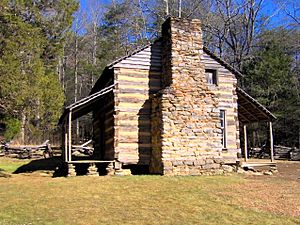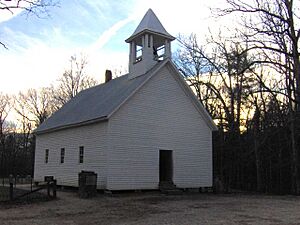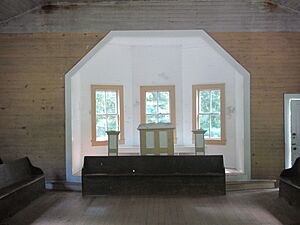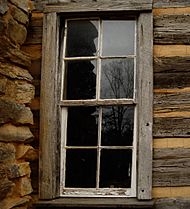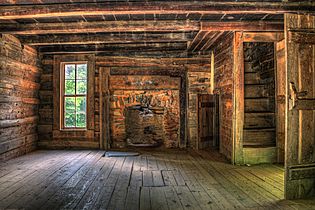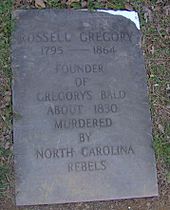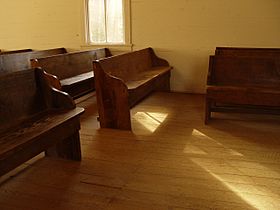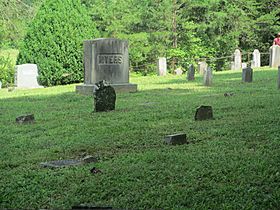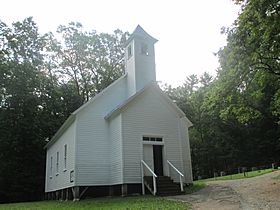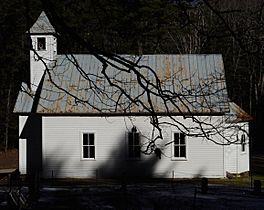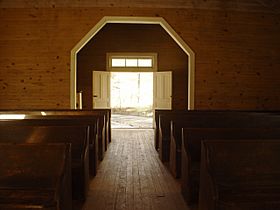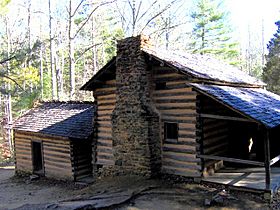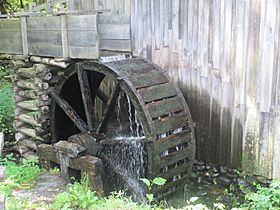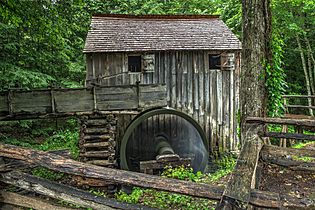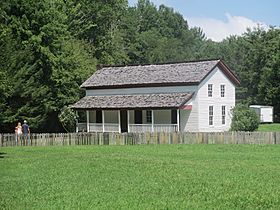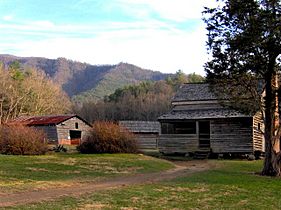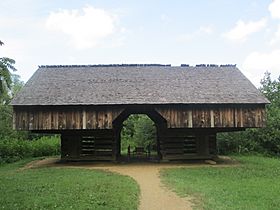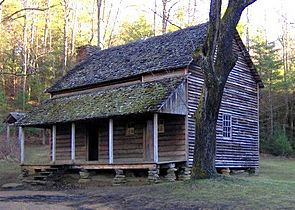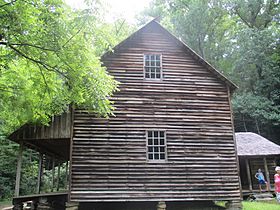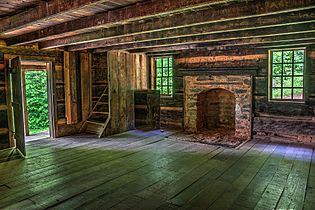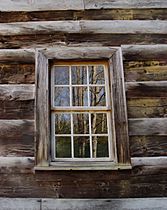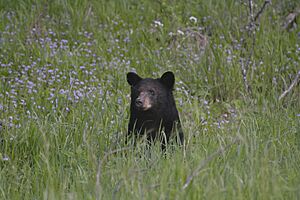Cades Cove facts for kids
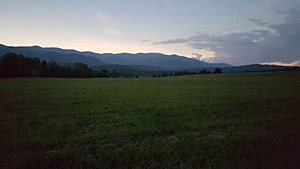
Cades Cove is a beautiful, quiet valley located in the Tennessee part of the Great Smoky Mountains National Park. Before the park was created, many families lived here. Today, Cades Cove is the most popular spot for park visitors. Over two million people come each year to see its old homes, amazing mountain views, and lots of wild animals. The Cades Cove Historic District is a special place listed on the National Register of Historic Places.
Contents
What is the Geology of Cades Cove?
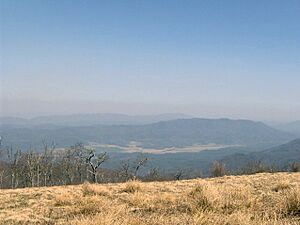
Cades Cove is a special type of valley called a "limestone window". This means that over a very long time, water wore away older, harder rocks. This uncovered softer Paleozoic limestone underneath. The harder rocks still form the tall mountains around the cove, like Rich Mountain and the Great Smoky Mountains crest. This makes Cades Cove feel very isolated. Because the limestone broke down easily, it created rich, fertile soil. This made Cades Cove a great place for early farmers to settle.
Most of the rocks in Cades Cove are sedimentary rock. They formed between 340 million and 570 million years ago. The mountains around the cove formed much later, about 200 million to 400 million years ago. This happened when the North American and African land plates slowly crashed into each other. This crash pushed older rock layers on top of younger ones.
What is Gregory's Cave?
The way the limestone and sandstone broke down in Cades Cove created several caves. The two biggest are Gregory's Cave and Bull Cave. Bull Cave is the deepest cave in Tennessee, going down 924 feet (282 meters). Inside Gregory's Cave, scientists have found Trilobite and brachiopod fossils.
The entrance to Gregory's Cave is about 10 feet (3 meters) wide and 4 feet (1.2 meters) high. The main part of the cave is a large passage, usually 20 to 55 feet (6 to 17 meters) wide and 15 feet (4.6 meters) high. This passage is 435 feet (133 meters) long. There's also a side passage about 300 feet (91 meters) from the entrance.
People used to mine for saltpeter in the cave. Saltpeter was an important ingredient for making gunpowder. You can still see "tally marks" on the walls and pickax marks in the dirt from this mining. This mining happened between 1818, when settlers first arrived, and 1865, the end of the Civil War.
Gregory's Cave was the only cave in the national park that was open to the public. It opened in July 1925. The Gregory family, who owned the land, continued to show the cave even after the property was bought for the national park in 1935. The cave had wooden walkways and electric lights for visitors.
During the Cold War, Gregory's Cave was chosen as a fallout shelter. It was meant to hold 1,000 people and was stocked with food and water. Today, Gregory's Cave is securely closed off. Only scientific researchers with special permits from the National Park Service are allowed to enter.
What is the History of Cades Cove?
Early History of the Valley
For many years, the Cherokee people used trails through the Smoky Mountains. These trails connected their villages in North Carolina to their settlements in Tennessee. One important trail went through Cades Cove. European traders also used these trails as early as 1740.
By 1797, the Cherokee had a small settlement in Cades Cove called "Tsiya'hi," meaning "Otter Place." This might have been a seasonal hunting camp. Cades Cove was named after a Cherokee leader called Chief Kade. Abrams Creek, which flows through the cove, was named after another chief, Abraham.
In 1819, a treaty ended all Cherokee claims to the Smokies. The Cherokee village in Cades Cove was soon abandoned. However, some Cherokee stayed in the nearby forests. They sometimes attacked settlers until 1838. That's when they were forced to move to Oklahoma during the Trail of Tears.
Who Were the First European Settlers?
John Oliver (1793–1863) and his wife Lurena Frazier (1795–1888) were the first European families to live permanently in Cades Cove. They arrived in 1818. The Olivers struggled through their first winter, surviving on dried pumpkin given to them by friendly Cherokees.
In 1821, William "Fighting Billy" Tipton bought a lot of land in Cades Cove. He sold it to his sons and other family members, and more people started to settle there. Peter Cable, a farmer, arrived in the 1820s. He created a clever system of ditches and gates to drain the wet parts of the cove. In 1827, Daniel Foute opened a forge to make metal tools. Robert Shields built a small mill in 1835, and his son Frederick built the cove's first gristmill. Other early settlers built homes on the surrounding mountains. These included Russell Gregory, for whom Gregory Bald is named.
Between 1820 and 1850, the population of Cades Cove grew to 671 people. Farms in the cove were usually between 150 and 300 acres (0.6 to 1.2 square kilometers). The early residents were mostly self-sufficient. However, they still depended on nearby Tuckaleechee Cove for things they couldn't make, like dry goods.
Cades Cove was not as isolated as some people think. A post office opened in 1833. By the 1890s, Cades Cove even had telephone service. By the 1850s, several roads connected Cades Cove to other towns.
How Did Religion Shape Cades Cove?
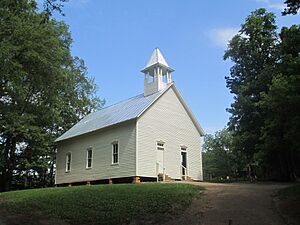
Religion was very important in Cades Cove from the beginning. John and Lucretia Oliver helped start a Baptist church in 1825. In the 1830s, a disagreement happened among Baptist churches in East Tennessee. This was called the Anti-mission Split. It was about whether missions were allowed by the Bible. This debate came to Cades Cove in 1839. It caused 13 members to leave and form the Cades Cove Missionary Baptist Church. The remaining church changed its name to the Primitive Baptist Church in 1841.
The Primitive Baptists believed in a very strict reading of the Bible. William Howell Oliver, a pastor from 1882 to 1940, explained their belief: "We believe that Jesus Christ Himself started the Church, that it was perfect from the beginning, suitable for every time and place, for every person, without any changes to fit new times or customs."
The Primitive Baptists were a strong religious and political group in the cove. Their meetings were only stopped by the Civil War. The Missionary Baptists had a smaller group but continued to meet.
The Cades Cove Methodist Church also started in the 1820s. The Methodist group was also small.
Cades Cove During the Civil War
Before the Civil War, the area around Cades Cove was a center for people who wanted to end slavery. The Quakers, who were against slavery, even fought with the Union army, even though they usually avoided fighting. The founder of Maryville College, Rev. Isaac L. Anderson, often spoke against slavery in Cades Cove. Because of these ideas, Cades Cove strongly supported the Union during the Civil War.
In 1863, Confederate soldiers from North Carolina started raiding Cades Cove. They stole animals and killed Union supporters. Elijah Oliver, John Oliver's son, had to hide in the mountains. With the death of John Oliver in 1863, the cove lost many of its original leaders.
Even after Union forces took control of Knoxville in 1863, Confederate raids continued. Russell Gregory, who had tried to stay neutral, formed a small group of older men. In 1864, they surprised a group of Confederates near Forge Creek. The Confederates were defeated and chased back to North Carolina. This mostly stopped the raids. However, a group of Confederates later snuck into the cove and killed Gregory.
Cades Cove suffered greatly from the Civil War for many years. It wasn't until around 1900 that the population returned to what it was before the war. Farms were less productive, and people were careful about any changes. The cove only started to recover economically in the early 1900s.
How Cades Cove Became a National Park
Of all the communities in the Smoky Mountains, Cades Cove resisted the creation of the Great Smoky Mountains National Park the most. At first, residents were told their land would not be part of the park. But in 1927, a law was passed that allowed the Park Commission to buy land for the park, even if owners didn't want to sell.
Long-time residents of Cades Cove were very angry. The head of the Park Commission, Colonel David Chapman, received threats. One sign near the cove's entrance read: "COL. CHAPMAN: YOU AND HOAST ARE NOTFY, LET THE COVE PEOPL ALONE. GET OUT. GET GONE. 40 M. LIMIT." The "40 mile" limit referred to the distance from Cades Cove to Chapman's hometown.
Despite the threats, Chapman started a lawsuit against John W. Oliver in 1929. The court first sided with Oliver, saying the federal government hadn't said Cades Cove was essential. But then the Secretary of the Interior officially announced the cove was needed. Another lawsuit was filed, and this time Oliver lost. The case even went to the Tennessee Supreme Court. Oliver fought several times over the value of his 375-acre (1.5 square kilometer) land. He wanted $30,000, but the court gave him $17,000. After renting his property for a few years, Oliver finally left on Christmas Day in 1937. The Primitive Baptist Church continued to meet in Cades Cove until the 1960s, even though the Park Service wanted to develop the land.
For about 100 years before the park, people farmed and logged a lot in the valley. This caused many trees to be cut down. At first, the National Park Service planned to let the cove grow back into a forest. But they later decided to keep Cades Cove as a meadow. They removed newer buildings and kept only the old cabins and barns. These buildings showed what pioneer life was like in early Appalachia.
What Historical Structures Can You See in Cades Cove?
Quick facts for kids |
|
|
Cades Cove Historic District
|
|

Becky Cable House
|
|
| Lua error in Module:Location_map at line 420: attempt to index field 'wikibase' (a nil value). | |
| Location | 10 mi. SW of Townsend in Great Smoky Mountains National Park |
|---|---|
| Nearest city | Townsend, Tennessee |
| Built | 1818 |
| NRHP reference No. | 77000111 |
| Added to NRHP | July 13, 1977 |
Cades Cove is a special historic district listed on the National Register of Historic Places since July 13, 1977. This means it's an important area with historic buildings and old archaeological sites.
The National Park Service takes care of several buildings in Cades Cove. These buildings show what life was like for pioneers in the 1800s. When the cove became part of the park, most residents lived in more modern houses. The park preserved the older log cabins and barns.
Here are some of the historic buildings you can see along the Cades Cove Loop Road:
- The John Oliver Cabin, built around 1822–1823. This was the home of the cove's first permanent European settlers. The Olivers first lived in an old Cherokee hut, then a simple structure, before building this cabin.
- The Primitive Baptist Church, built in 1827. This church was first called the Cades Cove Baptist Church. It changed its name in 1841 after a disagreement about missions. The Olivers and Russell Gregory are buried in its cemetery.
- The Cades Cove Methodist Church, built in 1902. Methodists were active in the cove as early as the 1820s. They built their first meeting house in 1840.
- The Cades Cove Missionary Baptist Church, with the current building constructed in 1915–1916. This church was formed in 1839 by a small group of Baptists who disagreed with the main church about missions.
- The Myers Barn, built in 1920. This is a more modern-looking hay barn. It is located along the trail to the Elijah Oliver Place.
- The Elijah Oliver Place, built in 1866. Elijah Oliver was the son of John and Lucretia Oliver. His first farm was destroyed during the Civil War. This homestead includes a dog-trot cabin, a chicken coop, a corn crib, a spring house, and a simple stable.
- The John Cable Grist Mill, built in 1868. John P. Cable had to build a series of diversions along Mill Creek and Forge Creek. This was to get enough water power for the mill's large overshot wheel.
-
Gristmill at John Cable house
-
- The Becky Cable House, built in 1879. This building is next to the Cable Mill. It was first a general store. In 1887, it was sold to Rebecca Cable, John Cable's daughter. Other buildings have been moved here, including a barn, a carriage house, a chicken coop, and a replica of a blacksmith shop.
- The Henry Whitehead Cabin, built 1895–1896. This cabin is located on Forge Creek Road. It was built by Matilda "Aunt Tildy" Shields and her second husband, Henry Whitehead.
- The Dan Lawson Place, built by Peter Cable in the 1840s. Dan Lawson acquired it after marrying Cable's daughter, Mary Jane. Lawson was the wealthiest resident in the cove. The homestead includes a cabin, a smokehouse, a chicken coop, and a hay barn.
- The Tipton Place, built in the 1880s by the family of William "Fighting Billy" Tipton. The house later had wood panels added. The homestead also includes a carriage house, a smokehouse, a woodshed, and a famous double-cantilever barn.
- The Carter Shields Cabin, a rustic log cabin built in the 1880s.
How Can You Tour Cades Cove?
Even though Cades Cove is isolated, it's a very popular place to visit in the Great Smoky Mountains National Park. An 11-mile (18 km) paved loop road goes around Cades Cove. Thousands of visitors drive this loop every day. During busy times, it can take more than four hours to drive and see all the sites. Cades Cove gets about 5 million visitors each year. It is the most popular spot in the entire Great Smoky Mountains National Park.
Many people come to Cades Cove to see black bears. But many also visit for the great hiking and the well-preserved 19th-century homes. On most days, you can see many deer in the meadows and woods. Popular hiking trails include the path to Abrams Falls, which is almost a 5-mile (8 km) round trip. Another trail leads to Gregory Bald, named after Russell Gregory. Besides driving and sightseeing, horseback riding and bicycling are also popular activities in the cove.




